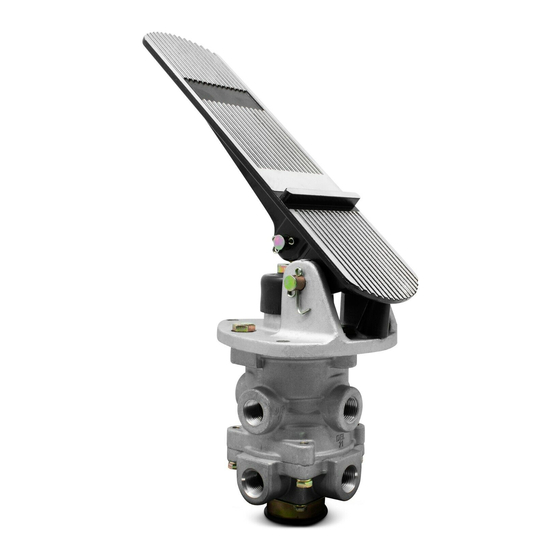BENDIX E-6 Manual - Halaman 4
Jelajahi secara online atau unduh pdf Manual untuk Unit Kontrol BENDIX E-6. BENDIX E-6 8 halaman. Dual brake valves
Juga untuk BENDIX E-6: Data Layanan (6 halaman)

SERVICE CHECKS
OPERATING CHECK
Check the delivery pressure of both primary and secondary
circuits using accurate test gauges. Depress the treadle to
several positions between the fully released and fully
applied positions, and check the delivered pressure on the
test gauges to see that it varies equally and proportionately
with the movement of the brake pedal.
After a full application is released, the reading on the test
gauges should fall off to zero promptly. It should be noted
that the primary circuit delivery pressure will be about 2 PSI
greater than the secondary circuit delivery pressure with
both supply reservoirs at the same pressure. This is normal
for this valve.
Important: A change in vehicle braking characteristics or a
low pressure warning may indicate a malfunction in one or
the other brake circuit, and although the vehicle air brake
system may continue to function, the vehicle should not be
operated until the necessary repairs have been made and
both braking circuits, including the pneumatic and mechani-
cal devices, are operating normally. Always check the vehicle
brake system for proper operation after performing brake
work and before returning the vehicle to service.
LEAKAGE CHECK
1. Make and hold a high pressure (80 psi) application.
2. Coat the exhaust port and body of the brake valve with a
soap solution.
3. Leakage permitted is a 1" bubble in 3 seconds. If the
brake valve does not function as described above or leak-
age is excessive, it is recommended that it be replaced
with a new or remanufactured unit, or repaired with genu-
ine Bendix parts available at authorized Bendix parts
outlets.
REMOVAL
1. Check the vehicle wheels or park the vehicle by
mechanical means. Drain all air system reservoirs.
2. Identify and disconnect all supply and delivery lines at
the brake valve.
3. Remove the brake valve and treadle assembly from the
vehicle by removing the three cap screws on the outer
bolt circle of the mounting plate. The basic brake valve
alone can be removed by removing the three cap screws
on the inner bolt circle.
DISASSEMBLY
(Figures 3 and 4)
1. If the entire brake valve and treadle assembly was re-
moved from the vehicle, remove the three cap screws
securing the treadle assembly to the basic brake valve.
4
2. Remove the screw (9) securing the exhaust diaphragm
(10) and washer (11) to the exhaust cover (12).
3. Remove the four screws that secure the exhaust cover
(12) to the lower body.
4. Remove the Secondary inlet and exhaust valve assem-
bly (13) from the lower body.
5. Remove the four hex head cap screws securing the lower
body to the upper body and separate the body halves.
6. Remove the rubber seal ring (14) from the lower body.
™
E-6
VALVE ONLY (Figure 3):
7. While applying thumb pressure to the primary piston, lift
out and up on the three lock tabs of the primary piston
retainer (15).
E-10
™
VALVE ONLY (Figure 4):
8. A.
While depressing spring seat (7), remove retaining
ring (8).
B.
Remove spring seat and coil spring (5).
9. Using a 3/8" wrench, hold the lock nut (16) on the
threaded end of the stem (17) in the primary piston (2).
Insert a screwdriver in the exhaust passage through the
center of the valve and engage the slotted head of the
stem.
10. Remove lock nut (16), spring seat (18), stem spring (19),
primary piston (2), and primary piston return spring (6).
Remove o-ring (34).
11. Remove adapter (1). Remove o-ring (4) from adapter.
Caution: Before proceeding with the disassembly, refer
to Figure 4 and note that the lock nut and stem are used
to contain the primary piston return spring, stem spring
and the relay piston spring. The combined force of these
springs is approximately 50 pounds and care must be
taken when removing the lock nut as the spring forces
will be released. It is recommended that the primary
piston and relay piston be manually or mechanically
contained while the nut and stem are being removed.
™
E-6
VALVE ONLY:
12. Using a screwdriver to restrain the stem, as in step nine,
remove the lock nut (16), spring seat (18) and stem
spring (19).
13. Remove the relay piston (20), relay piston spring (21),
primary piston and primary piston return spring (23) from
the upper body. Use care so as not to nick seats.
™
Note: Certain E-6
valves do not have a relay piston spring
(21). If none is found, none should be replaced.
14. On valves manufactured after October 7,1976, a small
washer (24) will be found in the cavity in the lower side
of the primary piston (22).
15. Disassemble the primary piston by rotating the spring
seat nut (25) counterclockwise. Separate the spring seat
